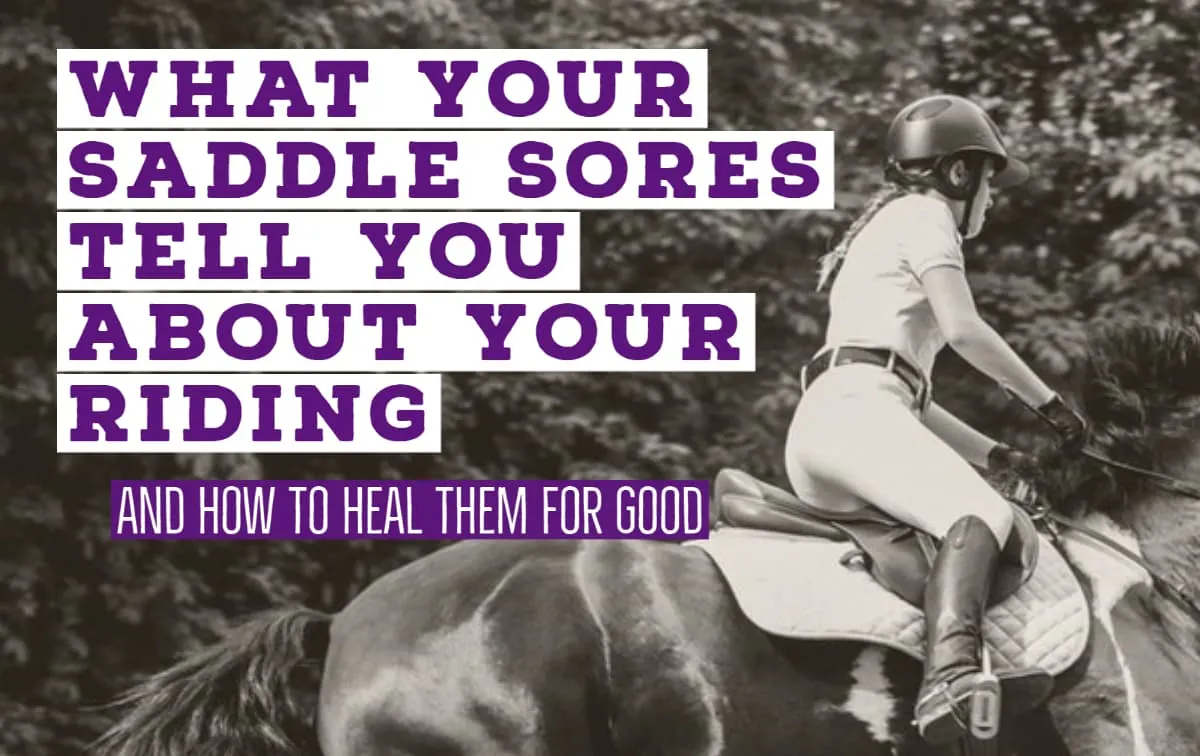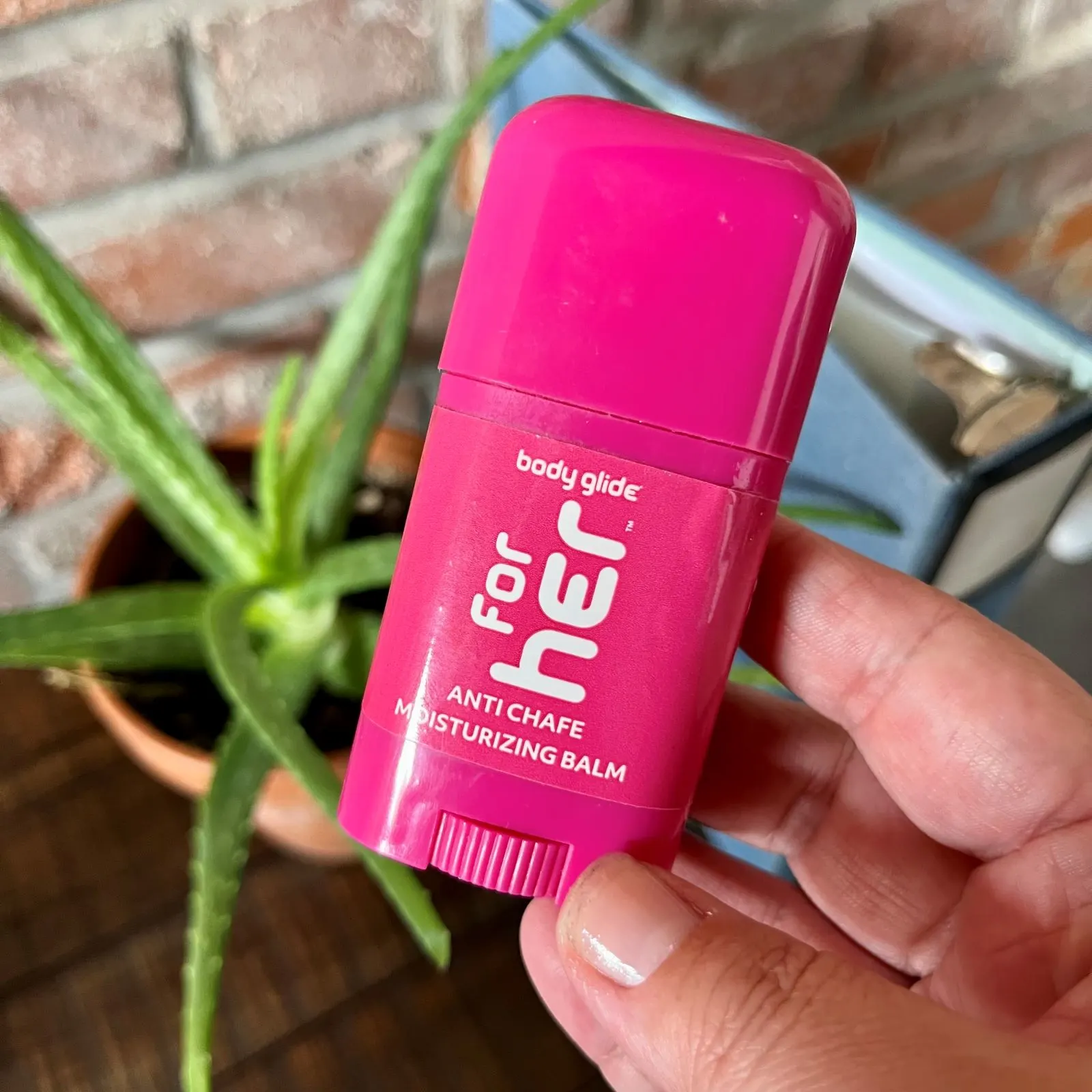Saddle sores are a specific type of sores that horseback riders sometimes get on their inner legs, groin, and buttocks. These wounds are created when sensitive skin is subjected to heat, friction, and moister (like sweat). They are most common for new riders, riders spending long hours in the saddle, and riders with improperly fit saddles or riding clothing.
Minor saddle sores are part of the experience of learning to ride, but saddle sores that cause pain or break the skin aren’t normal. When saddle sores appear, it’s usually a cue that preventative measures are needed.
Factors that impact saddle sores include:
- riding position
- skin type
- how your saddle fits your body
- clothing
- and how your body perspires
In this article, we’ll first cut to the chase: 8 ways to FIX the saddle sore problem. Then, we’ll discuss some of the causes in depth and explore how where your saddle sores show up can help you learn how to navigate horseback riding in your particular body.

The Top 8 Ways to Prevent Saddle Sores
The following section may contain affiliate links. As an Amazon Associate, we earn from qualifying purchases.
We are lucky to have many modern solutions for preventing saddle sores. The top 8 prevention methods, in no particular order, are:
Runner’s Anti-chafe Stick
Beloved by runners and those with chafing issues, skin lubricant in a deodorant-like stick prevents saddle sores by reducing friction and is my go-to solution because it’s cheap and often totally ends the problem when applied to skin prior to riding.
Horseback riding athletes aren’t the only ones who experience chafing and friction-related skin issues. Thankfully, the running industry has provided a number of high-performance skin lubricants. These work by in two ways: 1. Reducing friction by adding a lubricant 2. By protecting the skin with an oil-based layer that stays put through sweating.

Saddle Fit
For a horse, having a poorly fit saddle is agony. Sometimes, horses can get saddle sores under their saddle.
But horses aren’t the only ones who can get saddle sores from poor saddle fit. The same is true for riders! Saddles with too narrow of a “twist” (that’s the pommel of the saddle, the highest point that rests against a rider’s groin) is one common cause of saddle fit related saddle sores.
There are two good ways to troubleshoot if saddle fit is the cause of your saddle sores:
- To find out if your saddle is the cause of your saddle sores, have your saddle fit evaluated by a professional professional saddle fitter.
- Assuming that your horse does not need a specialized tree, trial-ride a few other saddles. (Be sure and give yourself plenty of time out of the saddle to let your saddle sores heal, as once they’ve begun, they might be irritated by any saddle)
Riding Bareback to Prevent Saddle Sores
One way to check if your saddle is to blame is by riding without a saddle. Bareback riding can help troubleshoot saddle sores while also developing your balance.
Ride bareback, bareback riding – though more difficult – generally has fewer pressure points where bodies meet the horse’s back. Because of this, it can be a good way to ride while you’re healing from a particularly bad subtle sore.
Bareback riding can be challenging, especially for beginner riders, however using a bareback pad or riding with full seat breaches (which, themselves can be a solution for saddle sores) can help support your balance by adding the right kind of friction and grip.
Riding Instruction

Position, pinching, and weight distribution can cause chafing that leads to saddle sores. Because of this, seeking professional instruction may help.
Riding lessons can help us to develop a balanced, soft, and secure seat. A good seat eliminates many issues.
If you don’t have a riding instructor or have access to one nearby, check out the book Centered Riding by Sally Swift. This classic book was published in the 1980’s and has been consistently popular since then because the methods are so effective for developing a more comfortable, secure seat for both English and Western riders.
Developing Tolerance
Although it’s everyone’s least favorite prevention method, if your saddle sores are mild (i.e. do not break the skin) you may find that with time your skin develops a tolerance for the friction.
Personally, I have found this only somewhat true for myself and my riders. In general, saddle sores that appear on the inner leg, calf, and thighs do tend to go away on their own, but saddle sores higher up generally appear on skin that is not meant to grow calluses!
Clothing
When many of us start riding, we choose clothes to wear horseback riding from our regular wardrobe. While this is a smart move initially (avoiding the expense of buying a whole new wardrobe for a brand-new sport we’re trying!) If you’re a new rider getting saddle sores while riding in jeans or leggings, it’s time to level up your riding attire.
Purposed designed riding gear is often the only step needed to eliminate chafing while riding.
With some exceptions, remember that you usually get what you pay for when it comes to riding gear, so if you test out this option it’s worth splurging on a pair of riding pants designed by a well-known equestrian brand.
Full Seat Breeches
One surprising way to eliminate friction is actually by increasing it: Full seat breeches are a style of riding pants that include a panel of suede that covers the crotch, buttocks, inner thighs, and inner knees. Where suede meets a leather saddle’s seat, these two very grippy surfaces stop sliding on each other.
Though it may be strange feeling at first, this type of riding pants grip the saddle and eliminate a lot of the minor movement that contributes to saddle sores.
Change Your Underwear!
Seams cause chafing, and chafing causes saddle sores! An effective method for eliminating saddle sores is eliminating seams- including the seams and hems of your undergarments. Switching to microfiber performance underwear or just going without can make a big different.
Use a Seat Alignment Exercise
The exercise shared in our article on how to learn to sit the trot can help align your position in a way that distributes weight and eliminates some types of saddle sores.
What Your Saddle Sores Tell you About Your Riding:
Not all saddle sores are equal, and paying attention to where exactly your skin gets irritated during riding can be a clue for how to prevent this problem in future rides.
If you get saddle sores on your inner legs:
Saddle sores on the ankle, calves, and inner knees might mean that you are gripping with your leg and causing extra friction. Sores here may also mean that your saddle’s stirrup leathers (the strap that holds the stirrup in place on an English saddle) are to blame.
Saddle sores on the inner legs often show up as friction burns – inflamed skin that burns similar to a carpet burn. These sores are why horseback riders traditionally wear boots that extend up the calf. English riders also have an option of leg protection known as “half chaps.”
Saddle Sores on Your Seat Bones
These saddle sores, the rarest, are often caused by weight carried farther back in the saddle than average. This may be due to riding with a less-than-ideal posture, which can be corrected through instruction, but may also be due to the structure of your saddle or the particular confirmation of your body. Consulting with a saddle fitter may be helpful, as well as adding special seat cushions to your saddle.
Saddle Sores on the Crotch
The most common saddle sores come from irritation to the sensitive skin around our genitals. To some degree, these types of saddle sores are normative – after a long ride skin irritation is not unusual. However, broken skin or lasting pain is not normal and should be investigated to treat and prevent in the future.
Saddle sores on the crotch are often related to 1. Saddle fit or 2. Choice of riding clothing or 3. Riding position.
Saddle Fit and Saddle Sores Between the Legs
The part of the saddle that is located directly under the front of a rider’s pelvis is known as the “twist.” It is important for the twist to be an appropriate size for the rider – too narrow or too wide and using the saddle can be uncomfortable for a rider. A great way to test if this issue is to ride in different saddles – just keep in mind that a saddle needs to fit both horse and rider for success, and may require working with a professional saddle fitter.
Clothing Choice and Saddle Sores
Saddle sores in the crotch area are the main reason that most riders ride in clothing specifically designed for horseback riding. Like any other sport, using the right equipment is critical. Both English and Western horseback riding supply companies sell specialized pants – styled as jeans, breeches, or yoga-inspired riding tights. These specially designed pants either eliminate or minimize seams in the crotch area – leaving less potential fabric to irritate skin and cause saddle sores.
Crotch Saddle Sores and Riding Position
Less common than the issues with clothing or saddles, are riders who develop saddle sores because they tilt their pelvis forward while riding. This directs the body weight away from the seat bones and onto the delicate tissues of the front of the pelvis. These issues can be corrected through work to develop a more stable seat and open posture while riding. Centered Riding by Sally Swift, is, again, my go-to recommendation for riders seeking to develop a seat that helps them ride with comfort and confidence.
Key Takeaways:
In conclusion, saddle sores can be a challenging and awkward-to-talk-about issue for horseback riders, particularly for newcomers or those spending long hours in the saddle with ill-fitting gear.
If you hear one thing from my advice, hear this: It’s crucial to listen to your body’s signals and take preventative measures as soon as saddle sores appear.
By following the top 8 prevention methods outlined here, riders can enhance their comfort and enjoyment while horseback riding. Remember that not all saddle sores are the same, and paying attention to their location can offer valuable clues to improve your riding experience in the future.


